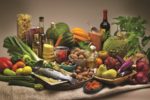No Excuses
Fruits & Veggies – More Matters® Month
If you need a great reason to incorporate more fruits and vegetables into your diet, you have 30 days in September to jump start that habit.
For a healthier life, the answer is quite simple: eat less, move more, go lightly on the junk food, and enjoy more fruits and vegetables. This inspires a balance of freshness and health. I hate to break it to you, but a slice of carrot cake, some pumpkin pie, a piece of zucchini bread, three glasses of wine and two Bloody Mary drinks do not equate to your daily requirement of fruits and vegetables. If you want to get your daily recommended amounts of these types of foods, you may have to make a few more deliberate changes in your diet.
It’s no secret fruits and vegetables offer myriad benefits to our overall health and well-being. As part of a healthy, well-balanced diet, these delicious foods help you stay strong and active. Rich with the vitamins, minerals and nutrients your body needs, adding this deliciousness into your daily meal plan can help minimize many adverse health risks, such as heart disease, obesity, high blood pressure, Type 2 diabetes and certain types of cancer.
Begin your commitment to add more fruits and vegetables to your daily menu during the month of September for the “Fruits & Veggies – More Matters® Month.”
USDA Recommendations – more fruits and vegetables for a fruitful life!
The USDA’s Dietary guidelines recommend adults eat anywhere between five to 13 servings of fruits and vegetables daily, depending on age, gender, physical activity and overall health.
Consuming more fruits and vegetables can also help you manage your weight. And when you eat healthier, you tend to feel more energetic. The more energetic you feel, the more likely you will be to commence and stick to a regular plan of physical fitness.
Additionally, if you have children and/or grandchildren, you can use this time to become a positive role model for them. How you eat will impact the food choices they make in the years to come. Why not set them up for success now?
So, what exactly is a serving?
To get you started down the fruits and veggies road, here are a few suggested single serving ideas:
- One small apple
- One large orange
- One banana
- One cup of leafy greens
- One small bell pepper
- One-half cup berries and grapes
- One-half cup cooked squash
- One-half cup raw fruits and veggies
“But fruits and vegetables just aren’t that appealing to me.”
Before you reach for the bag of chips or handful of M&Ms, consider exploring new recipes that use different types of vegetables. Replace the candy dish with a bowl of fresh fruit where the whole family can easily access it. Cut up various fruits and vegetables and keep them handy for a grab and go snack. If you are choosing pre-packaged fruits and vegetables, make sure they do not have added sugars.
At dinnertime, consider sautéing vegetables with some olive oil and then sprinkle in some of your favorite spices. For an added incentive, dip your veggies in your favorite dressing (in limited quantities, of course!), hummus or low-fat dip.
Drink your fruits and veggies!
How about a fruit and/or vegetable smoothie? These are perfect for that on-the-go treat. Try a strawberry-banana or green tea and blueberry mix or even a fruit and veggie mix. This is a delicious and simple way to get your daily servings of these important foods.
It’s easier than you think to get at least five servings a day.
Fruits and veggies are nutritious in any form – fresh, frozen, dried, canned and 100% juice. They are always ready when you are. Jam-packed with fiber, they keep you fuller longer and keep your digestive system running smoothly. Plus, they are low in calories. And with so many varieties, there is always something new, different and tasty to try.
At breakfast, add fruit to cereal, oatmeal or low-fat yogurt. Try a handful of berries or a sliced banana. Throw in some grilled mushrooms or tomatoes with your scrambled eggs.
At lunch, add some crunch to your sandwich with lettuce, tomatoes, cucumbers or even grated carrots. Add beans and lentils to soups, stews and salads. Cook with tomato or vegetable-based sauces, as they tend to be lower in fat than cream or cheese-based sauces.
At dinner, have a salad or a vegetable side dish with your main course.
For a snack, enjoy sliced cucumbers with cream cheese; sugar snap peas with low-fat hummus; or yogurt with mandarin orange sections.
Believe it or not, fruits and veggies are fun to eat, especially if you discover ways to grow them in your own backyard. Their variety of colors and textures also jazz up your plate.
So, keep calm and eat more fruits and vegetables. You owe it to yourself.






